Tensor-Free Holographic Metasurface Leaky-Wave Multi-Beam Antennas with Tailorable Gain and Polarization
Abstract
:1. Introduction
2. Simplification of the Tensor Impedance
2.1. Surface Impedance Tensor
2.2. Holography Theorem
3. Simultaneous TM and TE Beams
4. Design of the Unit Cell
5. Amplitude Control of Differently Polarized Beams
6. Circular Polarization
7. Sidelobe Suppression by Beam Cancellation
8. Measurements on Manufactured Prototype
9. Comparisons with Existing Literature
10. Comparison of Holographic Beamforming Arrays Afforded by the Present Design with Conventional Phased Arrays and Sector Antennas
11. Conclusions
Author Contributions
Funding
Institutional Review Board Statement
Informed Consent Statement
Data Availability Statement
Acknowledgments
Conflicts of Interest
References
- Fong, B.H.; Colburn, J.S.; Ottusch, J.J.; Visher, J.L.; Sievenpiper, D.F. Scalar and tensor holographic artificial impedance surfaces. IEEE Trans. Antennas Propag. 2010, 58, 3212–3221. [Google Scholar] [CrossRef]
- Oliner, A.; Hessel, A. Guided waves on sinusoidally-modulated reactance surfaces. IRE Trans. Antennas Propag. 1959, 7, 201–208. [Google Scholar] [CrossRef]
- Minatti, G.; Caminita, F.; Casaletti, M.; Maci, S. Spiral leaky-wave antennas based on modulated surface impedance. IEEE Trans. Antennas Propag. 2011, 59, 4436–4444. [Google Scholar] [CrossRef]
- Kock, W. Microwave Holography. Microwaves 1968, 7, 46–54. [Google Scholar]
- Christian Rusch. Holographic Antennas. In Handbook of Antenna Technologies; Springer Science + Business Media: Singapore, 2015. [Google Scholar]
- Checcacci, P.; Russo, V.; Scheggi, A. Holographic antennas. IEEE Trans. Antennas Propag. 1970, 18, 811–813. [Google Scholar] [CrossRef]
- Björnson, E.; Sanguinetti, L.; Wymeersch, H.; Hoydis, J.; Marzetta, T.L. Massive MIMO is a reality—What is next? Five promising research directions for antenna arrays. Digit. Signal Process. 2019, 94, 3–20. [Google Scholar] [CrossRef]
- Rappaport, T.S.; Xing, Y.; Kanhere, O.; Ju, S.; Madanayake, A.; Mandal, S.; Alkhateeb, A.; Trichopoulos, G.C. Wireless communications and applications above 100 GHz: Opportunities and challenges for 6G and beyond. IEEE Access 2019, 7, 78729–78757. [Google Scholar] [CrossRef]
- Bourdoux, A.; Barreto, A.N.; van Liempd, B.; de Lima, C.; Dardari, D.; Belot, D.; Lohan, E.-S.; Seco-Granados, G.; Sarieddeen, H.; Wymeersch, H.; et al. 6G White Paper on Localization and Sensing. arXiv 2020, arXiv:200601779. Available online: http://arXiv.org/abs/2006.01779 (accessed on 2 June 2020).
- Rajatheva, N.; Atzeni, I.; Bjornson, E.; Bourdoux, A.; Buzzi, S.; Dore, J.-B.; Erkucuk, S.; Fuentes, M.; Guan, K.; Hu, Y.; et al. White Paper on Broadband Connectivity in 6G. arXiv 2020, arXiv:200414247. Available online: http://arXiv.org/abs/2004.14247 (accessed on 29 April 2020).
- Elzanaty, A.; Guerra, A.; Guidi, F.; Dardari, D.; Alouini, M.-S. Toward 6G Holographic Localization: Enabling Technologies and Perspectives. IEEE Internet Things Mag. 2023, 6, 138–143. [Google Scholar] [CrossRef]
- Sievenpiper, D.F.; Colburn, J.; Fong, B.; Ottusch, J.; Visher, J. Holographic artificial impedance surfaces for conformal antennas. In Proceedings of the 2005 IEEE Antennas and Propagation Society International Symposium, Washington, DC, USA, 5 July 2005. [Google Scholar]
- Li, Y.; Li, A.; Cui, T.; Sievenpiper, D.F. Multiwavelength multiplexing hologram designed using impedance metasurfaces. IEEE Trans. Antennas Propag. 2018, 66, 6408–6413. [Google Scholar] [CrossRef]
- Pandi, S. Holographic Metasurface Leaky Wave Antennas. Ph.D. Dissertation, Arizona State University, Tempe, AZ, USA, May 2017. [Google Scholar]
- Comite, D.; Podilchak, S.K.; Baccarelli, P.; Burghignoli, P.; Galli, A.; Freundorder, A.P.; Antar, Y.M. Analysis and design of a compact leaky-wave antenna for wide-band broadside radiation. Sci. Rep. 2018, 8, 17741. [Google Scholar] [CrossRef] [PubMed]
- Li, Y.B.; Wan, X.; Cai, B.G.; Cheng, Q.; Cui, T.J. Frequency-controls of electromagnetic multi-beam scanning by metasurfaces. Sci. Rep. 2014, 4, 6921. [Google Scholar] [CrossRef] [PubMed]
- Minatti, G.; Caminita, F.; Martini, E.; Maci, S. Flat Optics for Leaky-Waves on Modulated Metasurfaces: Adiabatic Floquet-Wave Analysis. IEEE Trans. Antennas Propag. 2016, 64, 3896–3906. [Google Scholar] [CrossRef]
- Minatti, G.; Caminita, F.; Martini, E.; Sabbadini, M.; Maci, S. Synthesis of Modulated-Metasurface Antennas with Amplitude, Phase, and Polarization Control. IEEE Trans. Antennas Propag. 2016, 64, 3907–3919. [Google Scholar] [CrossRef]
- Bodehou, M.; Martini, E.; Maci, S.; Huynen, I.; Craeye, C. Multibeam and Beam Scanning With Modulated Metasurfaces. IEEE Trans. Antennas Propag. 2020, 68, 1273–1281. [Google Scholar] [CrossRef]
- González-Ovejero, D.; Minatti, G.; Chattopadhyay, G.; Maci, S. Multibeam by metasurface antennas. IEEE Trans. Antennas Propag. 2017, 65, 2923–2930. [Google Scholar] [CrossRef]
- Wen, Y.; Qin, P.-Y.; Maci, S.; Guo, Y.J. Low-Profile Multibeam Antenna Based on Modulated Metasurface. IEEE Trans. Antennas Propag. 2023, 71, 6568–6578. [Google Scholar] [CrossRef]
- Artiga, X.; Mira, F. Holographic design of arbitrary multi-beam leaky-wave antennas. In Proceedings of the 2017 Progress in Electromagnetics Research Symposium—Fall (PIERS—FALL), Singapore, 19–22 November 2017; pp. 2695–2699. [Google Scholar]
- Kampouridou, D.; Feresidis, A. Tunable multibeam holographic metasurface antenna. IEEE Antennas Wirel. Propag. Lett. 2022, 21, 2264–2267. [Google Scholar] [CrossRef]
- Ramo, S.; Whinnery, J.R.; Van Duzer, T. Fields and Waves in Communication Electronics, 2nd ed.; Wiley: New York, NY, USA, 1984. [Google Scholar]
- Tsai, Y.Z.; Vilenskiy, A.; Ivashina, M.; Kehn, M.N.M. Millimeter-Wave Holographic Metasurface Leaky-Wave Multi-Beam Antennas with Gain and Polarization Control. In Proceedings of the 2023 IEEE International Symposium on Antennas and Propagation and USNC-URSI Radio Science Meeting (USNC-URSI), Portland, OR, USA, 23–28 July 2023; pp. 65–66. [Google Scholar]
- Johnson, M.C.; Brunton, S.L.; Kundtz, N.B.; Kutz, J.N. Sidelobe canceling for reconfigurable holographic metamaterial antenna. IEEE Trans. Antennas Propag. 2015, 63, 1881–1886. [Google Scholar] [CrossRef]
- Li, Y.B.; Cai, B.G.; Cui, T.J. Design of multi-beam holographic leaky-wave antenna with one/two-dimension frequency sweep. In Proceedings of the 2014 IEEE-APS Topical Conference on Antennas and Propagation in Wireless Communications (APWC), Palm Beach, Aruba, 3–9 August 2014. [Google Scholar]
- Patel, A.M.; Grbic, A. A printed leaky wave antenna with a sinusoidally modulated surface reactance. In Proceedings of the 2009 IEEE Antennas and Propagation Society International Symposium, Charleston, SC, USA, 1–5 June 2009. [Google Scholar]
- Kildal, P.-S. Foundations of Antennas, A Unified Approach; Studentlitteratur: Lund, Sweden, 2000. [Google Scholar]
- Krishna, B.T.; Chandrasekhar, P. Reduction of sidelobe level using convolutional windows. In Proceedings of the 2012 1st International Conference on Emerging Technology Trends in Electronics, Communication & Networking, Surat, India, 19–21 December 2012; pp. 1–5. [Google Scholar]
- Hadarig, A.; Hoeye, S.V.; Vázquez, C.; Camblor, R.; Fernández, M.; Hotopan, G.; Alonso, L.; Las-Heras, F. 3D printed millimeter wave receiver integrating a graphene subharmonic mixer and a diagonal horn antenna. In Proceedings of the Global Symposium on Millimeter-Waves (GSMM), Montreal, QC, Canada, 25–27 May 2015; pp. 1–3. [Google Scholar]
- Ramalingam, S.; Balanis, C.A.; Birtcher, C.R.; Shaman, H.N. Polarization-Diverse Holographic Metasurfaces. IEEE Antennas Wirel. Propag. Lett. 2019, 18, 264–268. [Google Scholar] [CrossRef]
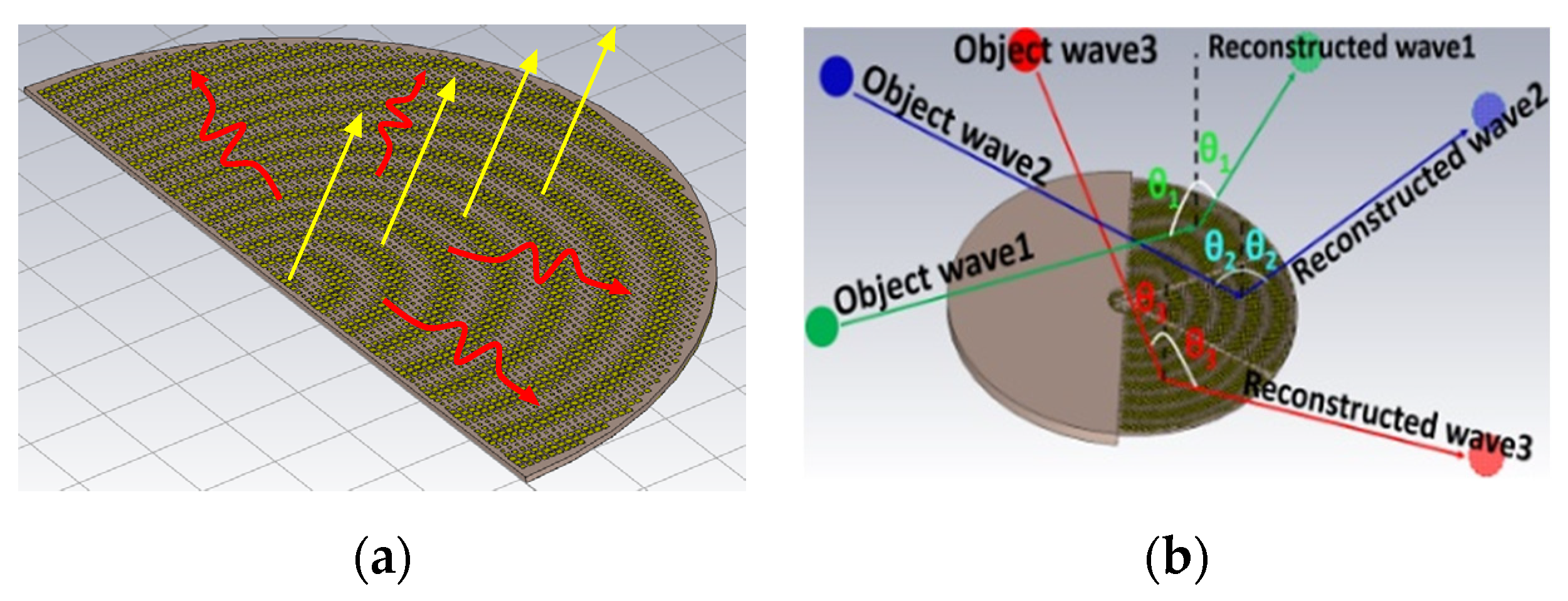
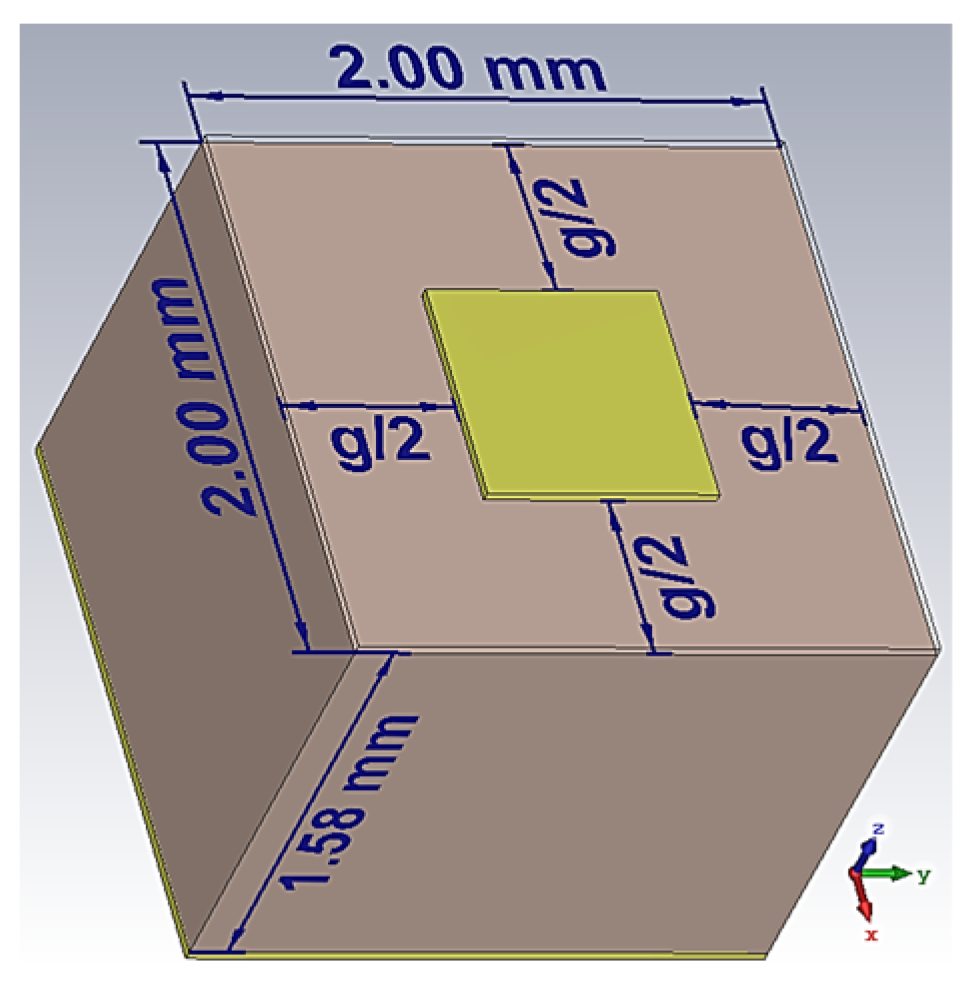

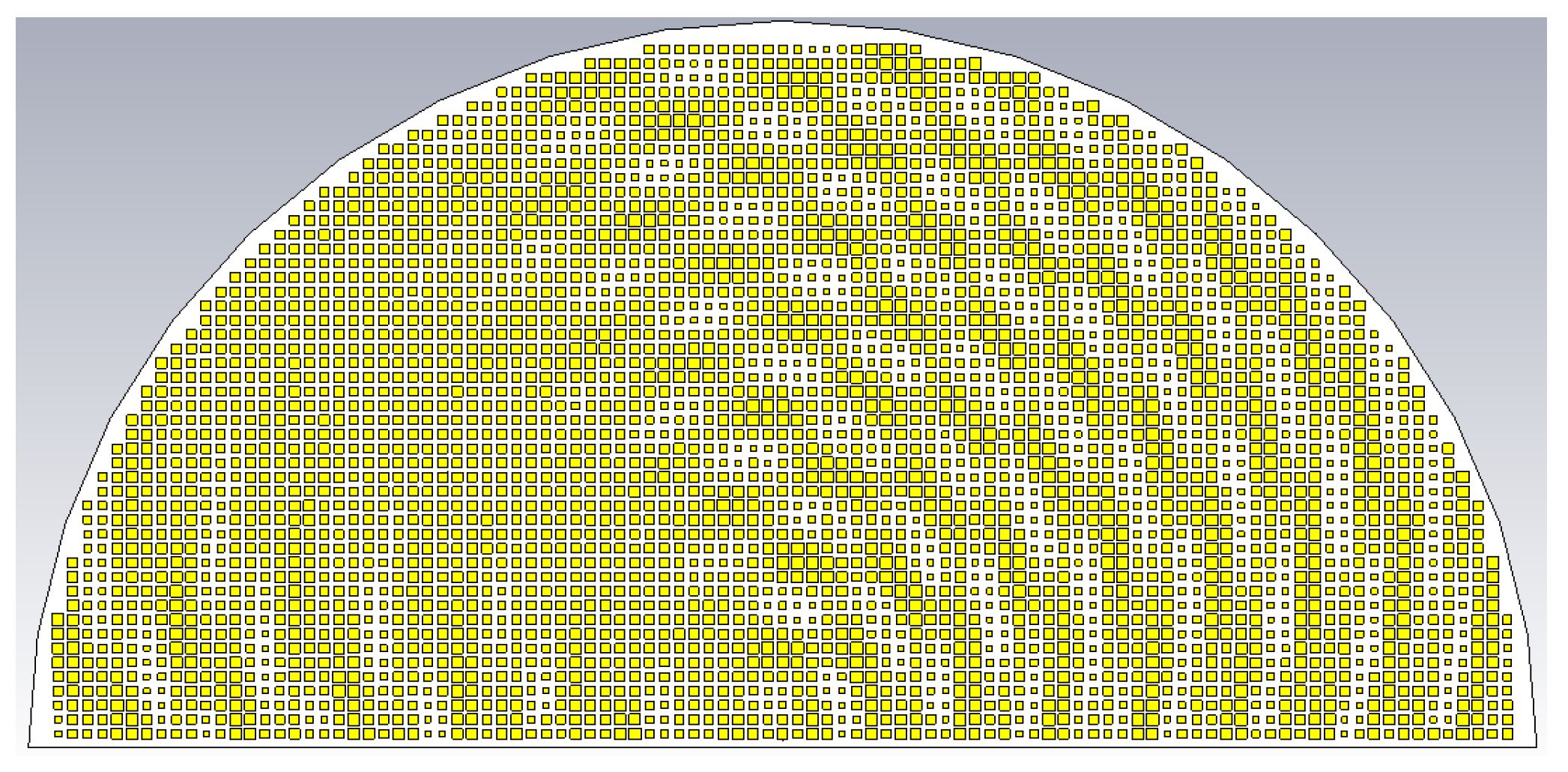






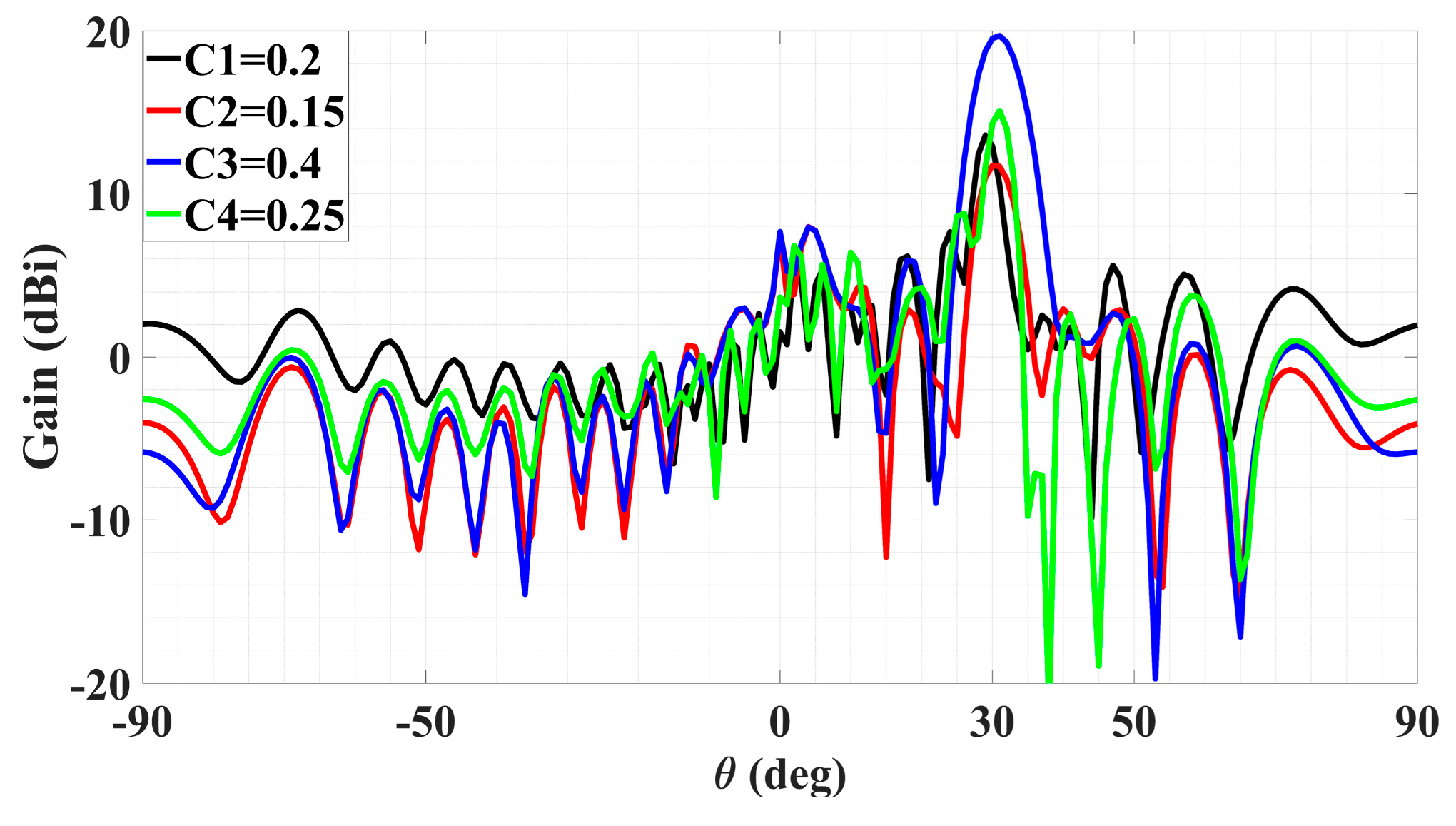



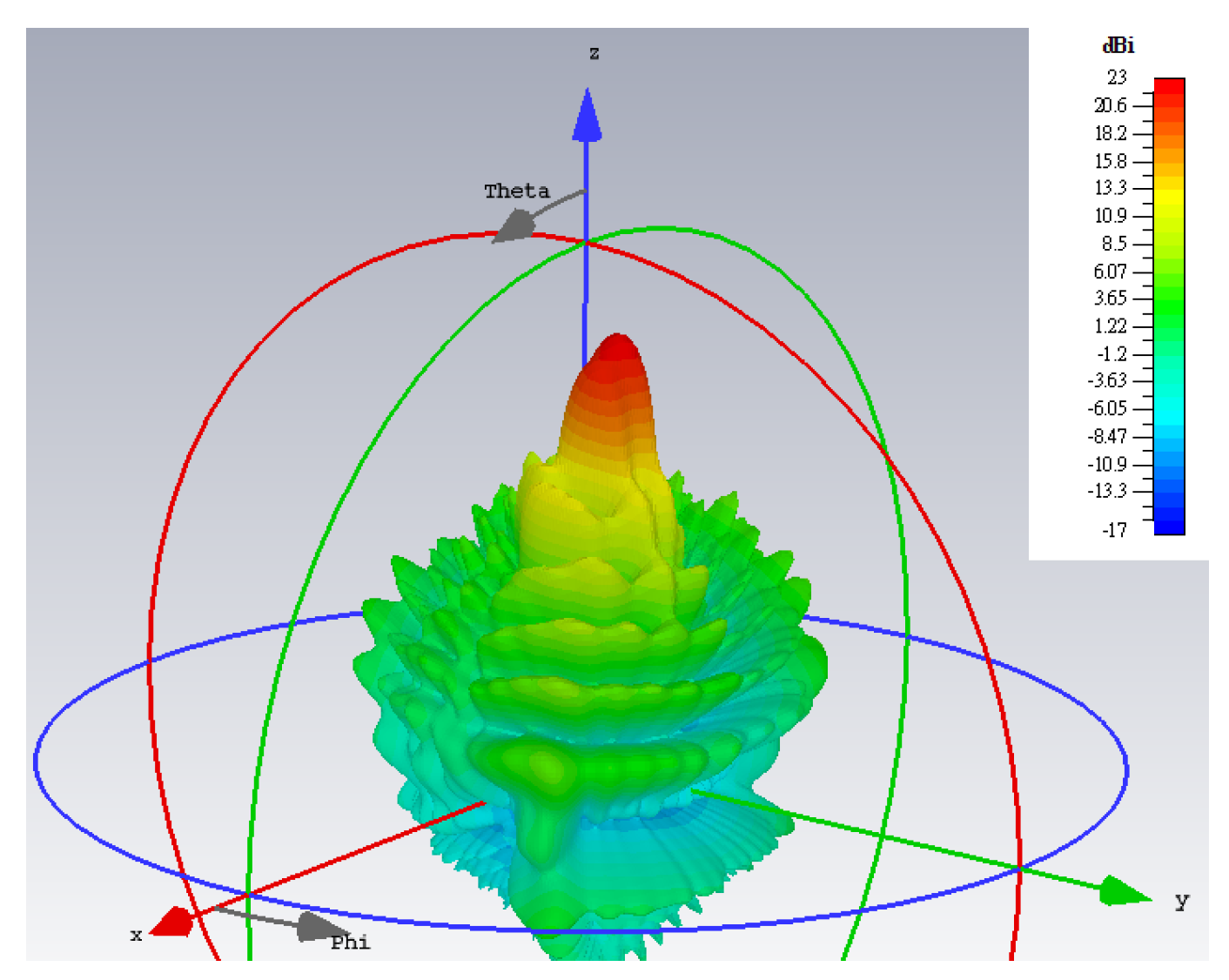


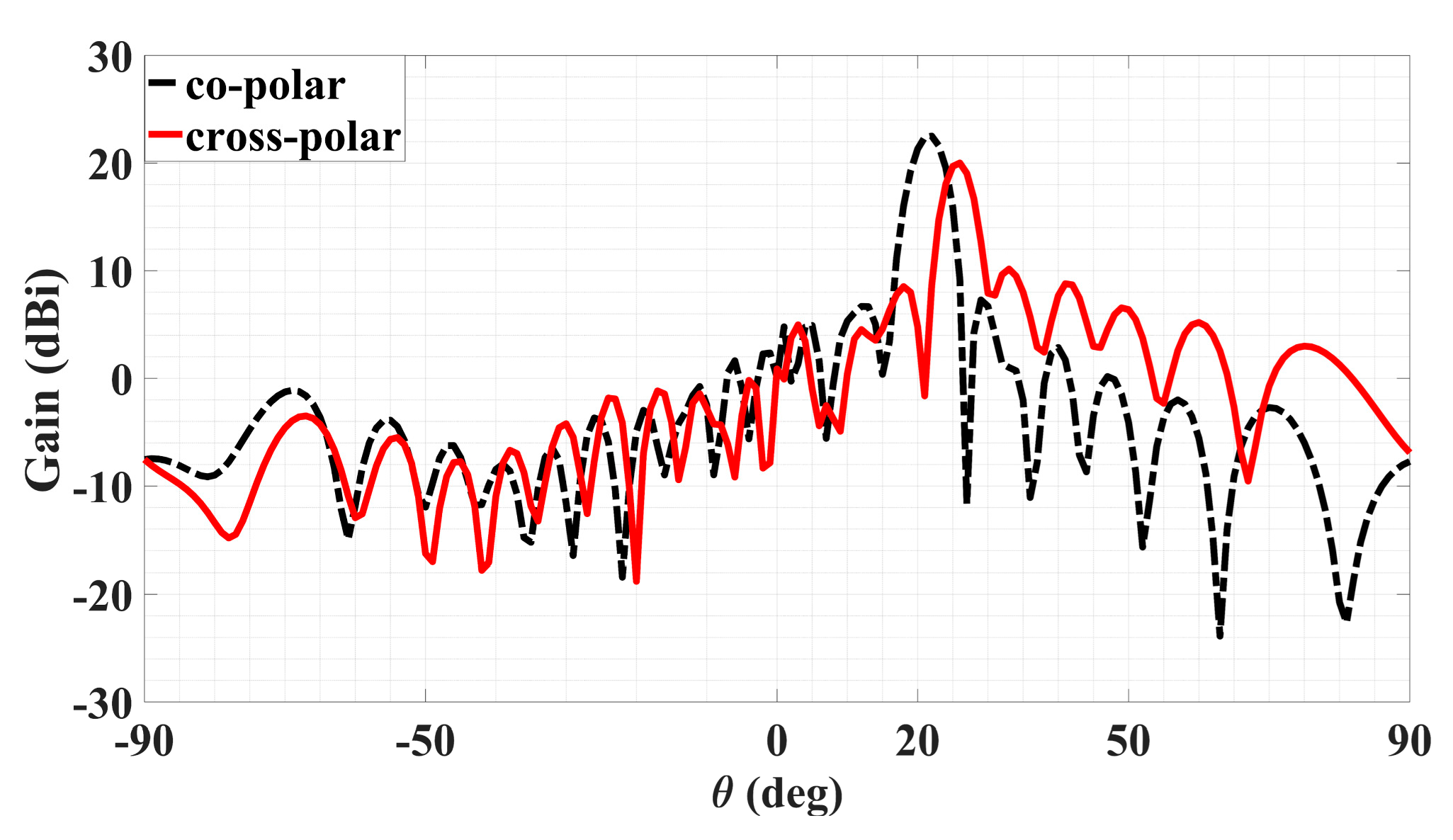







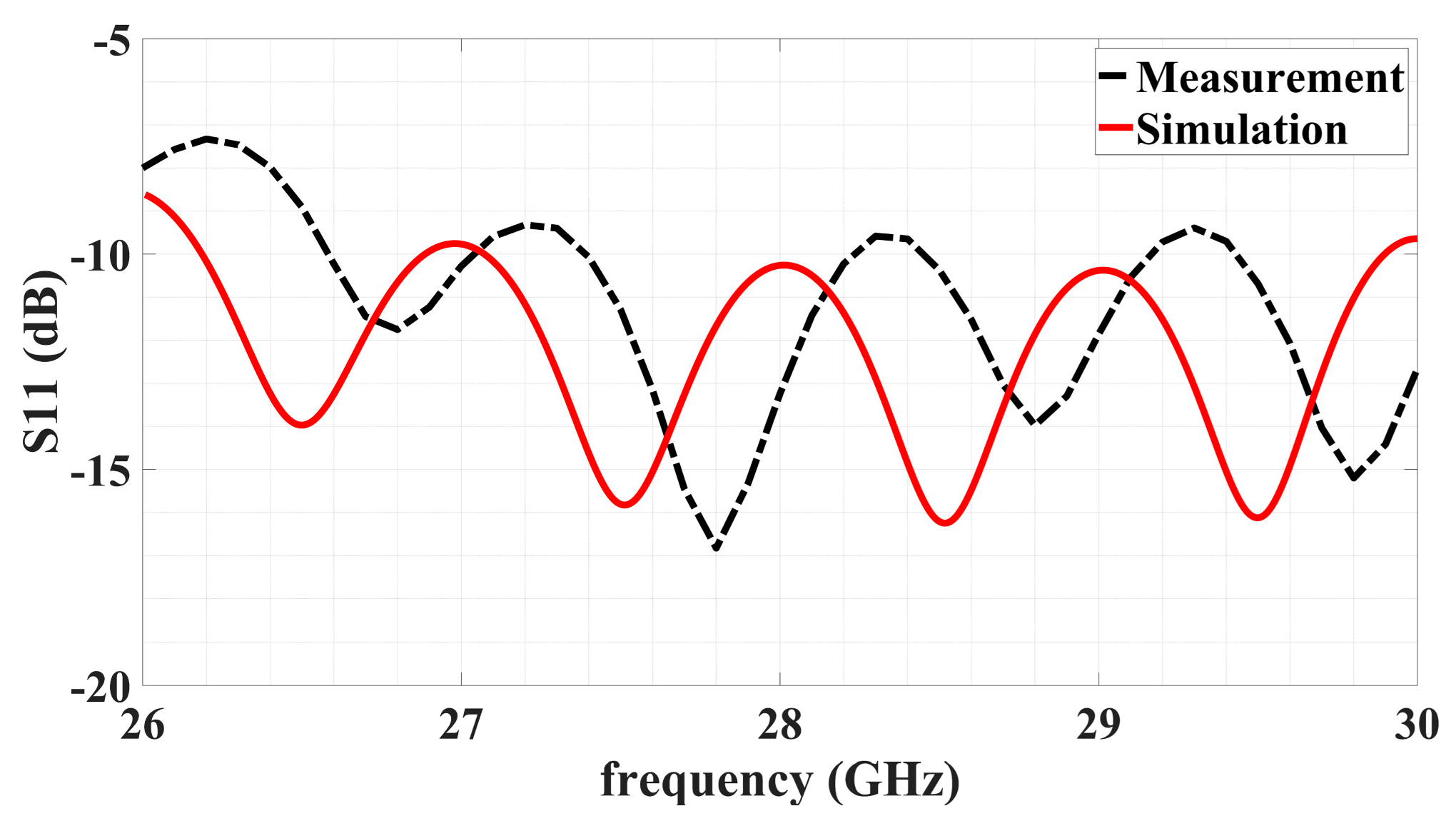

| Reference | Multiple Beams | Beams in Any Phi Plane | Gain Amplitude Control | Beam Polarization Control | Beam Phase Control | No Hologram Partitioning | Sidelobe Suppression and Compensation | Contains Measurement Results |
|---|---|---|---|---|---|---|---|---|
| [1] | ✗ | ✓ | ✗ | ✓ | ✓ | ✓ | ✗ | ✗ |
| [3] | ✗ | ✓ | ✗ | ✗ | ✓ | ✓ | ✗ | ✗ |
| [12] | ✗ | ✓ | ✗ | ✗ | ✗ | ✓ | ✗ | ✗ |
| [13] | ✗ | ✓ | ✗ | ✗ | ✗ | ✓ | ✗ | ✓ |
| [14] | ✗ | ✓ | ✗ | ✓ | ✓ | ✗ | ✗ | ✓ |
| [15] | ✗ | ✓ | ✗ | ✗ | ✗ | ✗ | ✗ | ✓ |
| [16] | ✓ | ✓ | ✗ | ✗ | ✗ | ✗ | ✗ | ✓ |
| [17] | ✗ | ✓ | ✓ | ✓ | ✓ | ✓ | ✗ | ✗ |
| [18] | ✗ | ✓ | ✓ | ✓ | ✓ | ✓ | ✗ | ✓ |
| [19] | ✓ | ✓ | ✓ | ✓ | ✓ | ✓ | ✗ | ✗ |
| [20] | ✓ | ✓ | ✓ | ✓ | ✓ | ✓ | ✗ | ✗ |
| [21] | ✓ | ✓ | ✓ | ✗ | ✗ | ✓ | ✗ | ✓ |
| [22] | ✓ | ✗ | ✓ | ✗ | ✗ | ✓ | ✗ | ✓ |
| [23] | ✓ | ✗ | ✓ | ✗ | ✗ | ✓ | ✗ | ✗ |
| [26] | ✗ | ✓ | ✗ | ✗ | ✓ | ✗ | ✗ | ✗ |
| [27] | ✓ | ✓ | ✗ | ✗ | ✗ | ✗ | ✗ | ✗ |
| [28] | ✗ | ✗ | ✗ | ✗ | ✗ | ✓ | ✗ | ✓ |
| [32] | ✓ | ✓ | ✓ | ✓ | ✓ | ✗ | ✗ | ✓ |
| Present work | ✓ | ✓ | ✓ | ✓ | ✓ | ✓ | ✓ | ✓ |
| Ref. | Freq (GHz) | Area of the Aperture | Number of Ports | Number of Beams | Realized Gain (dBi) | SLLs (dB) |
|---|---|---|---|---|---|---|
| [19] | 24 | 2 | 2 | 21.5 | 9 | |
| [21] | 14 | 7 | 7 | 20 | 10 | |
| [32] | 12 | 2 | 2 | 16 | 6 | |
| This work | 28 | 1 | 1TM + 1TE | 18 @ for TM 17.3 for TE | 7.84 for TM 9.61 for TE |
| Reference | (Meas.) | Co-Pol (Meas.) | Cross-Pol (Meas.) |
|---|---|---|---|
| [1] | ✗ | ✗ | ✗ |
| [3] | ✗ | ✗ | ✗ |
| [12] | ✗ | ✗ | ✗ |
| [13] | −25 dB (17 GHz) −17 dB (20 GHz) | 16.7 dB (17 GHz) 20.5 dB (20 GHz) | ✗ |
| [14] | ✗ | 15 dB (12 GHz) | 5 dB (12 GHz) |
| [15] | −18 dB (23 GHz) (sim.) | 15 dB (23 GHz) | ✗ |
| [16] | ✗ | −5 dB (16 GHz) (normalized) | ✗ |
| [17] | ✗ | ✗ | ✗ |
| [18] | ✗ | 28 dBi (8.4 GHz) | ✗ |
| [19] | ✗ | ✗ | ✗ |
| [20] | ✗ | ✗ | ✗ |
| [21] | −22.5 dB (14 GHz) | 20 dB (14 GHz) | 10 dB (14 GHz) |
| [22] | ✗ | 12 dB (18 GHz) | ✗ |
| [23] | ✗ | ✗ | ✗ |
| [26] | ✗ | ✗ | ✗ |
| [27] | ✗ | ✗ | ✗ |
| [28] | −9 dB (10 GHz) | 14.7 dB (10 GHz) | −22 dB (10 GHz) |
| [32] | ✗ | 15 dB (12 GHz) | 7.5 dB (12 GHz) |
| Present work | −13 dB (28 GHz) | 19 dB (TM) 13 dB (TE) | 10 dB (TM) 9 dB (TE) |
Disclaimer/Publisher’s Note: The statements, opinions and data contained in all publications are solely those of the individual author(s) and contributor(s) and not of MDPI and/or the editor(s). MDPI and/or the editor(s) disclaim responsibility for any injury to people or property resulting from any ideas, methods, instructions or products referred to in the content. |
© 2024 by the authors. Licensee MDPI, Basel, Switzerland. This article is an open access article distributed under the terms and conditions of the Creative Commons Attribution (CC BY) license (https://creativecommons.org/licenses/by/4.0/).
Share and Cite
Weng, C.-K.; Tsai, Y.-Z.; Vilenskiy, A.; Ng Mou Kehn, M. Tensor-Free Holographic Metasurface Leaky-Wave Multi-Beam Antennas with Tailorable Gain and Polarization. Sensors 2024, 24, 2422. https://doi.org/10.3390/s24082422
Weng C-K, Tsai Y-Z, Vilenskiy A, Ng Mou Kehn M. Tensor-Free Holographic Metasurface Leaky-Wave Multi-Beam Antennas with Tailorable Gain and Polarization. Sensors. 2024; 24(8):2422. https://doi.org/10.3390/s24082422
Chicago/Turabian StyleWeng, Chuan-Kuei, Yu-Zhan Tsai, Artem Vilenskiy, and Malcolm Ng Mou Kehn. 2024. "Tensor-Free Holographic Metasurface Leaky-Wave Multi-Beam Antennas with Tailorable Gain and Polarization" Sensors 24, no. 8: 2422. https://doi.org/10.3390/s24082422





